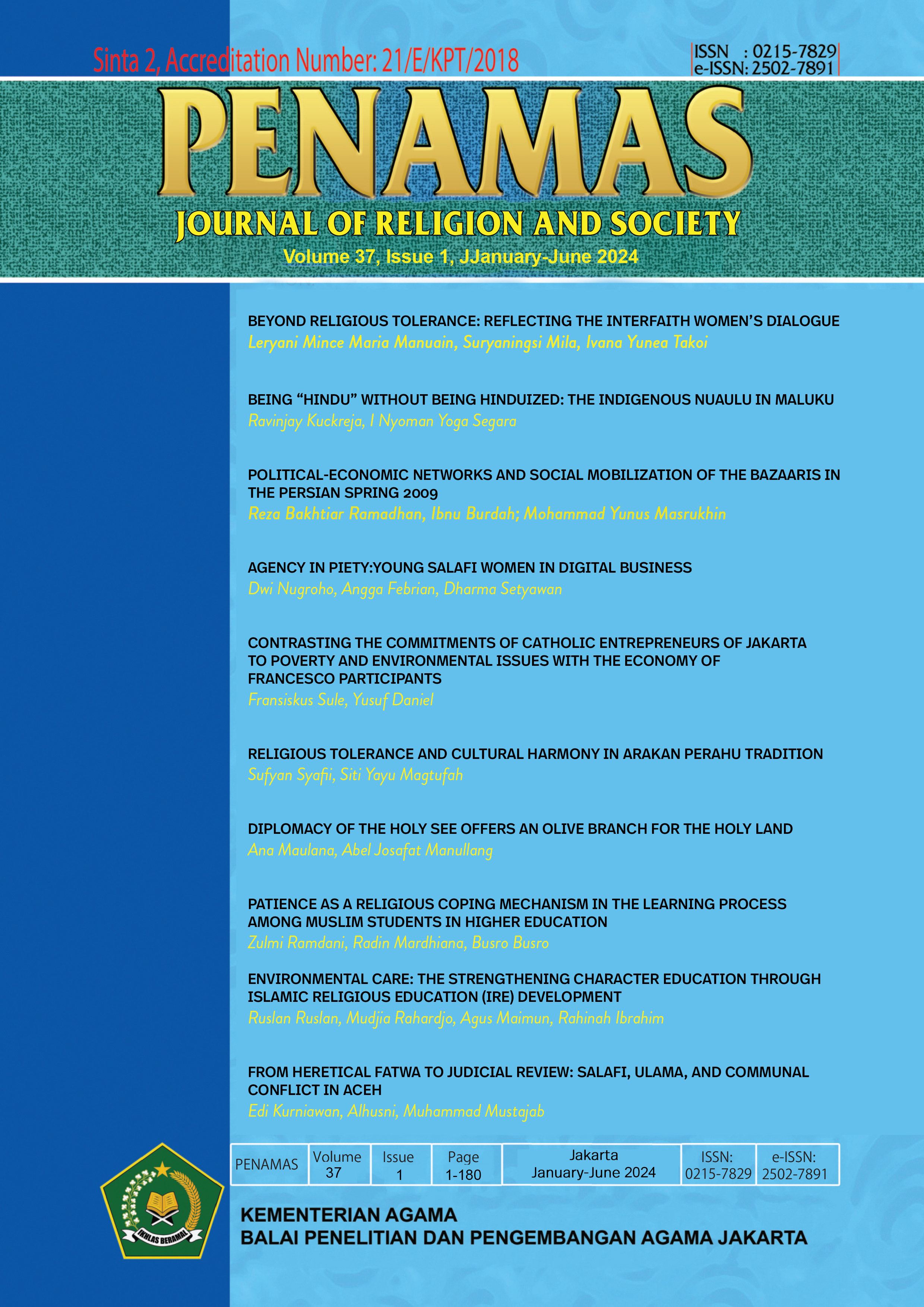BEING “HINDU” WITHOUT BEING HINDUIZED: THE INDIGENOUS NUAULU IN MALUKU
DOI:
https://doi.org/10.31330/penamas.v37i1.787Abstract
Fearing discrimination from the Indonesian government, the Nuaulu tribe in Central Maluku have chosen to declare themselves as “Hindu”. Their ancestral customs are similar to mainstream Hindu beliefs and traditions. However, they lack the Hindu Gods, the Sanskrit mantras and the unifying scripture of the Vedas. What is left is a local indigenous religion. However, their bad experience with being categorized as an ancestral faith (aliran kepercayaan) has led them to be self-declared Hindus. In such a circumstance, Hinduism can either unconditionally accept them despite the lack of evident resemblance, or the Nuaulu tribe can alter their religion’s façade to duplicate crucial Hindu identifiers. This paper questions what it means to be a Hindu, what Hinduization is, and how discriminatory definitions torment indigenous religions.
References
Amira (2021). Sejarah Kerajaan Ternate Tidore. Among Karta.
Amirullah, Thaufik, I Nyoman Nurjaya, and Bambang Sugiri. (2014). “Pertimbangan Hukum Hakim dalam Memutus Perkara Pembunuhan Berencana dengan Motif Persembahan Upacara Adat oleh Suku Noaulu Maluku Tengah (Studi Terhadap Putusan Nomor 87/Pid.B/2005/Pn.Msh dan Putusan Nomor 25/Pid/2006/Pt. Mal).” Jurnal Hukum 3 (1): 6–7. http://hukum.studentjournal.ub.ac.id/index.php/hukum/article/view/695.
Ananta, Aris, Evi Nurvidya Arifin, M.Sairi Hasbullah, Nur Budi Handayani, and Agus Pramono. (2015). Demography of Indonesia’s Ethnicity. Singapore: Institute of Southeast Asian Studies. https://doi.org/10.1355/9789814519885.
Aziz, Ahmad Amir. (2009). “Islam Sasak: Pola Keberagaman Komunitas Islam Lokal di Lombok.” Millah: Jurnal Studi Agama 8 (2): 241–53. https://doi.org/10.20885/millah.vol8.iss2.art3.
Barker, Chris. (2014). Kamus Kajian Budaya. Edited by Natan Arya. Translated by B. Hendar Putranto. Yogyakarta: PT Kanisius.
Barth, Fredrik. (1969). Ethnic Groups and Boundaries: The Social Organization of Culture Difference. Long Grove, Illinois: Waveland Press.
Berger, Peter L., and Luckman Thomas. (1966). The Social Construction of Reality: A Treatise in the Sociology of Knowledge. New York: Garden City.
Blackburn, S. H. (1985). Death and Deification: Folk Cults in Hinduism. History of Religions, 24(3), 255–274. http://www.jstor.org/stable/1062256
Blumer, Herbert. (1969). Symbolic Interaction. New York: Prentice Hall.
Bourdieu, Pierre. (1977). Outline of a Theory of Practice. Cambridge: Cambridge University Press.
———. (1979). Algeria. Cambridge: Cambridge University Press.
———. (2010). Arena Produksi Kultural Sebuah Kajian Sosiologi Budaya. Translated by Yudi Santoso. Yogyakarta: Kreasi Wacana.
Comaroff, John L, and Jean Comaroff. (2009). Ethnicity, Inc. Chicago and London: The University of Chicago Press.
Covarrubias, Miguel. (1973). Island of Bali. New York: A. Knoff Inc.
Cortesão, A. (1994). The Suma Oriental of Tome Pires: Volume I (1st ed.). Hakluyt Society.
Darmapoetra, Juma. (2013). Tolotang. Keteguhan Memegang Tradisi. Makassar: Arus Timur.
———. (2014). Suku Bugis. Pewaris Keberanian Leluhur. Makassar: Arus Timur.
Dashefsky, Arnold, and Howard M. Shapiro. (1975). Ethnic Identity in Society. Edited by Dashefsky. Chicago: College Publishing Company.
Fahham, A. Muchaddam (2016). Sistem Religi Suku Nuaulu di Pulau Seram Maluku Tengah. Pusat Penelitian Badan Keahlian DPR RI.
Geertz, Clifford. (1973). The Interpretation of Culture. New York: Basic Books.
Glazer, Nathan, and Daniel P. Moynihan, eds. (1975). Ethnicity Theory and Experience. Massachusetts, and London, England.: Harvard University Press Cambridge.
Goodenough, Ward. H. (2003). “In Pursuit of Culture.” In Annual Review of Anthropology 32, 1–32.
Haddock, Bruce, and Peter Sutch, eds. (2003). Multiculturalism, Identity, and Right. London and New York Press: Routledge.
Hall, Stuart. (1991). Culture, Globalization and The World-System: Contemporary Conditions for The Representation of Identity. Edited by Anthony D. King. Houdmills, Basingstoke, Hampshire and London: MacMillan Education Ltd.
Haryatmoko. (2010). “Habitus dan Kapital dalam Strategi Kekuasaan, Teori Strukturasi Pierre Bourdieu.” In Seminar Pascasarjana Jurusan Sosiologi, FISIP Universitas Indonesia.
Hutton, J. H. (1928). “The Significance of Head-Hunting in Assam.” The Journal of the Royal Anthropological Institute of Great Britain and Ireland 58: 399–408. https://doi.org/10.2307/2843630.
Koentjaraningrat. (1987). Sejarah Antropologi I. Jakarta: UI Press.
Lorenzen, D.N. (1999). Who Invented Hinduism? In Comparative Studies in Society and History, 41(4), 630-659.http://www.jstor.org/stable/179424
McDaniel, June. (2007). “Hinduism.” In The Oxford Handbook of Religion and Emotion, edited by Corrigan, John, 52–53. Oxford University Press.
Mujabuddawat, Muhammad Al. (2018). “Jejak Kedatangan Utusan Majapahit Di Pulau Ambon.” PURBAWIDYA: Jurnal Penelitian Dan Pengembangan Arkeologi, vol. 7, no. 1, 2018, p. 53, https://doi.org/10.24164/pw.v7i1.254.
Mulyana, S. (2006). Tafsir Sejarah Nagara Kretagama. Yogyakarta: PT LKis Pelangi Aksara Yogyakarta.
Moore, Henrietta L. (1998). Feminisme dan Antropologi. Translated by Tim Proyek Studi Jender dan Pembangunan FISIP UI. Jakarta: Obor.
Nicholson, Andrew J. (2010). Unifying Hinduism: Philosophy and Identity in Indian Intellectual History. Colombia University Press.
Nowak, Manfred. (2005). UN Covenant on Civil and Political Rights CCPR Commentary. 2nd ed. Arlington USA: NP. Angel Publisher.
Pattikayhatu, J. A. (2012). Bandar Niaga di Perairan Maluku dan Perdagangan Rempah- Rempah. Kapata Arkeologi,8(1), 1–8.
Picard, Michel. (2006). Bali Pariwisata Budaya dan Budaya Pariwisata. Translated by Jean Couteau and Warih Wisatsana. Jakarta: Forum Jakarta-Paris.
Putnam, Robert D. (1993). Making Democracy Work: Civic Traditions in Modern Italy. Princeton: Princeton University Press.
Rasmianto. (2009). “Interrelasi Kiai, Penghulu dan Pemangku Adat dalam Tradisi Islam Wetu Telu di Lombok.” Jurnal El-Harakah 11 (2): 138–54.
Rudyansjah, Tony. (2009). Kekuasaan, Sejarah, dan Tindakan. Sebuah Kajian tentang Lanskap Budaya. Jakarta: Rajawali Press.
Sen, Sailendra Nath (1999). Ancient Indian History and Civilization. New Age International.
Segara, I Nyoman Yoga, I Ketut Gunarta, I Nyoman Alit Putrawan, and I Made Adi Brahman. (2020). “Hindu Alukta: Sejarah, Keberadaan, Aktivitas, dan Dinamikanya di Tana Toraja, Sulawesi Selatan.” Universitas Hindu Negeri I Gusti Bagus Sugriwa. Denpasar.
Soekmono, R. (1973). Pengantar Sejarah Kebudayaan Indonesia 1. Yogyakarta: Kanisius.
Sokefeld, Martin. (1999). “Debating Self, Identity, and Culture in Anthropology.” Current Anthropology 40 (4): 417–47. https://doi.org/https://doi.org/10.1086/200042.
Spradley, James P. (2007). Metode Etnografi. Translated by Misbah Zulfa Elizabeth. Yogyakarta: Tiara Wacana.
Stott. (2017). Integration and Conflict in Indonesia’s Spice Islands. The Asia-Pacific Journal, 15(11).
Tanudirjo, D. A. (2013). Interaksi Regional dan Cikal Bakal Perdagangan Internasional di Maluku. KALPATARU, Majalah Arkeologi, 22(1), 1–6.
Utami, Ritna Wati. (2015). Pengembangan Civic Culture Melalui Pendidikan Formal dan Budaya Lokal Masyarakat Suku Nuaulu. Bandung: Universitas Pendidikan Indonesia.
Varshney, Ashutosh. (2022). Konflik Etnis dan Peran Masyarakat Sipil; Pengalaman India. Translated by Badan Litbang dan Diklat Kementerian Agama. Jakarta: Badan Litbang dan Diklat Kementerian Agama.
Widayanti, Rini, Hery Wijayanto, Woro Danur Wendo, and Rony Marsyal Kunda. (2015). “Identifikasi Keragaman Genetik Gen 12S Ribomsom RNA sebagai Penanda Genetik untuk Penentuan Spesies Kuskus (Identification of Genetic Diversity 12srrna Genes as Genetic Marker for Determining Species Cuscus).” Jurnal Veteriner 16 (2): 227–35.
Winaya, A. (2015). Peran Museum Majapahit sebagai Mediator Pelestarian Warisan Budaya. Amerta, 33(2), 97–110.
Zuhdi, Muhammad Harfin. (2006). “Parokialitas Adat terhadap Pola Keberagamaan Komunitas Islam Wetu Telu di Desa Bayan Lombok.” Jurnal Kontekstualitas. Jurnal Penelitian Sosial Keagamaan 21 (2): 71–94.
Downloads
Published
Issue
Section
License
Copyright (c) 2024 Penamas

This work is licensed under a Creative Commons Attribution-NonCommercial-ShareAlike 4.0 International License.









